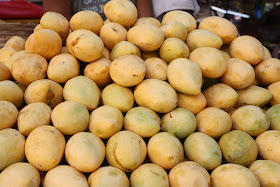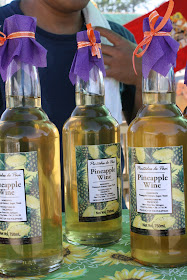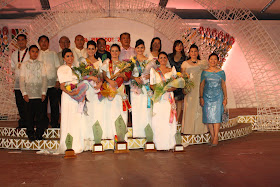
The history of this town dates back as early as 1766 when the first settlement was founded by three Malayan brothers named Dig-on, Tokiab, and Umawang. Their first formal community was located on the site presently occupied by the Roman Catholic Church.
Passi was just a settlement founded by the three brothers at the beginning of her history. This settlement (purok) was well protected from possible attacks from adjacent purok due to the gold treasures owned by them and buried underground and was supposed to be a mining region of gold from which these riches came.
The founding of the present poblacion of Passi was attributed to Don Martin Saligumba. His notable title"Don" indicated his leadership and power over the group. In 1766 when the Spanish administration recognized the exixtence of Passi as “Pueblo” he became first Capitan Basal actual of this place.Under his regime, Passi started its way towards progressive reforms.
The first Catholic Church was built during this time as an “ermita” later, an Agustinian friar began the construction of a formal church on an old site. When reverend father Apolinar Villanueva came into this parish he started the construction of the present church and was finally completed by one Padre Pedro. Then a succession of the first Passinhon priest in the person of reverend father Doc. Amado Panes Perfecto,D.C.I.
Passi is always proud of her geographical attraction and beautiful scenery for it is located at the central part of Panay. She is proud of the richness and abundance of her cultural heritage, her early and glorious history and versatility of her people’s love for beauty and art; the people’s financial capabilities which are expressed in their excessive merriment and exuberance in the celebration of festivals; she can be found in the mid – point of the railway line between Iloilo and Capiz and is the Central terminal of the Philippine Railway Company;
Passi was the pre – war capital of Iloilo Province in January 1942 to April 16, 1942 until the landing of the Japanese occupation force;
She was made the Quartermaster Depot of the USAFE for the food of the Army that resisted in Bataan through Capiz;
All her buildings in the Central School became the seat of the provincial government offices including the Agricultural and Industrial Bank and the Philippine National Bank before the Japanese landing in Panay;
Passi has the first warehouse of the Compania General de Tabacos de Filipinas in Central Panay which lately became the Catholic Church and also bodega of the USAFE for foodstuff for Corrigidor and Bataan;
The old Roman Catholic Church was made the Japanese garrison for occupying the house of Mayor Palmares before 1945 which edifice was also the office of the Civil Resistance Government of Passi when the Japanese token force evacuated, retaken by the Japanese and made their occupation rampant until they finally evacuated when the Americans landed in Leyte;
Barrio Jaguimitan was made the seat of the Municipal Resistance Government under Mayor Filoteo Palmares and Municipal Treasurer Pedro Oro during the war years;
Ibajay cave and mountain northeast of the poblacion was made the seat of the I.C.S. of the guerilla army under Mayor Santiago Imperial and Captain Patricio Miguel and was also interment camp for civilian prisoners, fifth columnist or pro Japanese Filipino who were caught by the army and imprisoned;
Barrio Camiri San Enrique, Passi became the cradle of the first guerilla organization of Panay and Romblon under Colonel Macario Peralta and Major Abelardo Muyco, etc.
The first strike sounded by the guerilla force and ambush led by the late Lieutenant Alberto Perlas, a daring young officer, was made at the railroad station of Bita-ogan by holding up the train manned by Japanese, killing them all and some Filipinos in protest of the Japanese occupation of Passi and Iloilo in August 1942.
Passi Central Elementary School had the first clean and beautiful ground in the province before the war;
One of the first regional high schools established in Iloilo was in Passi soon after liberation and one of the first to have acquired the widest site for high schools of 12 hectares; its athletic field cut from a hill and bulldozed by Mayor Palmares, improved, leveled, and beautiful in time for the most lavished Unit Athletic Meet ever held in the interior in 1949-1959;
The record of Passi in holding the First Provincial Athletic Meet in the interior before the war and in sustaining all the athletic delegates from different towns in Iloilo most abundantly and freely of which some meat uneaten were only given to them gratis et amore and some heads of cattle (surplus) sold for athletic fund-still unbroken up to this day – a feat that has never been or will ever be equaled in the history of athletic meets in Iloilo;
In matters of bestowing the old Filipino traditional customs of being hospitable to individual visitor, visiting teams and districts, Passi’s record is yet unsurpassed because sumptuous foods and drinks offered by the truckloads and caritos flow like water without reservation of any kind.
Passi has the biggest cattle ranch in Panay before the war because of her wide grazing land;
Her market is the one of the biggest in the interior and can be proud of big market collection every Monday and Friday, her market days;
Passi therefore was the biggest supplier of meat for the army during the war and also the biggest supplier of rice and corn for sustenance of the guerilla forces and the provincial guards of the Civil Resistance Movement of Free Panay and Romblon Gov. Tomas Confessor;
She also suffered the greatest number of deaths (both soldiers and civilians) as a result of several Japanese penetration and airplane bombings of military target and trouble on account of her size;
Passi, through her community school program, community education and improvement is beginning to regain her lost prestige and reputation as the cleanest and the most beautiful town in the interior of Iloilo or elsewhere;
She has established its First City College in October 2005 under Mayor Elyzer C. Chavez and
became progressive and experienced tremendous development over the period. Because of its strategic location, Passi became the center for trade and commerce bringing more investment opportunities. With high income, population growth and land area, Passi became the first component city of Iloilo in 1998.






















